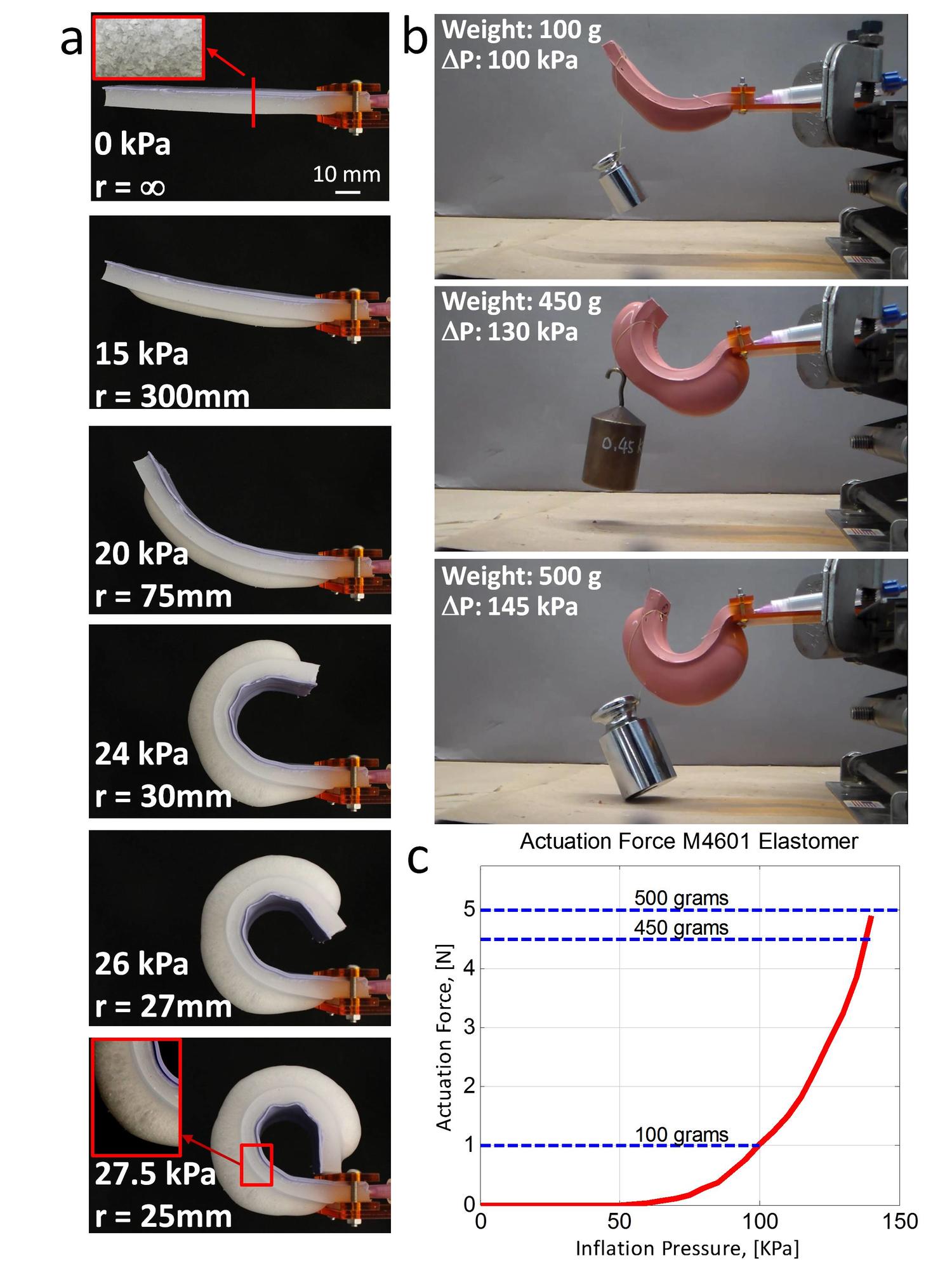This sections describes testing that was performed on two material systems: ammonium bicarbonate with MoldMax60 silicone (available from Smooth-On) and the table salt with several silicones.
Ammonium bicarbonate foams: tensile tests and blocked force measurements
 To characterize the mechanical properties of the foam, we performed uniaxial tensile tests on samples of φ = 0, 0.5, 0.6, and 0.7 porosity (i.e., pore volume fraction) and measured the forces applied by the sealed actuators via blocked force measurements.
To characterize the mechanical properties of the foam, we performed uniaxial tensile tests on samples of φ = 0, 0.5, 0.6, and 0.7 porosity (i.e., pore volume fraction) and measured the forces applied by the sealed actuators via blocked force measurements.
Tensile tests on the unsealed foams show a trend of decreasing elastic modulus as porosity increases (Adjacent Figure a). The average tensile moduli, measured at ε = 1, of the φ = 0, 0.5, 0.6, and 0.7 porous foams were E ≈ 508 kPa ± 28, 200 kPa ± 31, 83 kPa ± 6, and 48 kPa ± 19, respectively. The average ultimate tensile stresses and strains were σUTS ≈ 2.22 MPa ± 0.09, 0.40 MPa ± 0.02, 0.24 MPa ± 0.02, and 0.064 MPa ± 0.04 and εult ≈ 3.56 ± 0.22, 1.97 ± 0.10, 2.35 ± 0.09, and 1.58 ± 0.16 for the φ = 0, 0.5, 0.6, and 0.7 porous foams, respectively. The low variation within these samples (n = 3 for each porosity tested) indicates good repeatability even though the foams are stochastically structured. The data also show that all foams can stretch to ε >> 2 before failure; this elongation is essential to obtain large actuation amplitudes. Within the data, we also note that the pure ( φ = 0) PDMS has a higher ultimate strain, ε ULT ≈ 3.3, than the foam materials.
To characterize the performance of the actuators, we performed blocked force measurements on φ = 0.6 and φ = 0.7 porous samples. This measurement constrains bending actuators to a specific curvature (Adjacent Figure b) and measures applied force as a function of inflation pressure (Adjacent Figure c). Due to its lower modulus, the φ = 0.7 porous foam actuates at lower pressures however it also fails at ΔP ≈ 50 kPa. The φ = 0.6 porous actuator inflates to higher pressures (ΔP ≈ 80 kPa) without developing an aneurysm, and therefore applies a larger force.
Ammonium bicarbonate foams: air flow measurements
 Additionally, we characterized the airflow rate through foam samples, since this parameter dictates actuation speed. We measured the input and output pressures across a foam disc (radius, r = 1.25 cm and thickness, d = 1.25 cm) while measuring the air flow rate through the system.
Additionally, we characterized the airflow rate through foam samples, since this parameter dictates actuation speed. We measured the input and output pressures across a foam disc (radius, r = 1.25 cm and thickness, d = 1.25 cm) while measuring the air flow rate through the system.
To record airflow measurements through the foam, we used a custom-built acrylic cell to bond a cylindrical foam sample within rigid tubing (Adjacent Figure a). We then hermetically sealed the tubing using bolted end plates and rubber o-ring gaskets. We designed this mount to contain the applied pressure and ensure air permeated a constant foam cross-section. We then increased the pressure differential across the foam from 0 to 104 kPa (0 to 15 psi) while measuring the flow rate downstream of the sample. We fabricated both soft and rigid foam samples for this measurement: the soft, elastomeric foam was silicone (MoldMax60, Smooth-On; E = 2 MPa, reported) and the rigid foam an epoxy (System 3000, FibreGlast; E = 16 GPa, reported). Due to the detection limits of our instruments, we required the higher modulus MoldMax60 over MoldMax10 to attain sufficient flow rates for measurement. All foam-fabrication parameters and procedures were unchanged when using MM60 and System 3000 epoxy. As seen in the Adjacent Figure b, the soft foams exhibited considerably higher flow than the rigid foams. We also observed the expected behavior that for a given material, a higher porosity resulted in a higher flow rate for all applied pressures.
From these results, we attempted to model the airflow through the foam using established theory. Discussion of this model is located in the Modeling section.
Table salt foams mechanical tests: tensile tests and air flow measurements
To characterize the mechanical properties of the cured foams three different porosities samples have been molded: ϕpore=0.5, 0.6, 0.7. Then uniaxial, monotonic tensile tests (3 samples per porosity) were performed, according to the ASTM D412 standard (Zwick & Roell Z010, elongation rate of 50 mm min-1). As a reference, uniaxial tensile tests on pure elastomer (ϕpore=0.0) have been performed.
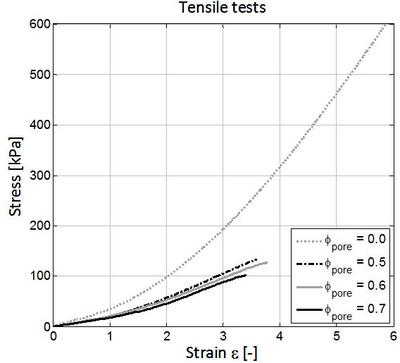
Towards predicting actuator inflation rates, flow rate measurements through foams with three different porosities have been performed. We molded 150 mm long cylindrical samples of diameter 25 mm and cut them into 15 mm lengths. We then glued the samples to the inner surface of rigid acrylic tubes with length and inner diameter of 25 mm using Sil-Poxy silicone rubber adhesive (Smooth-On, Inc.), leaving 5 mm of space above and below the sample. Next, we mounted each tube between two 3D printed caps and rubber O-rings to make the tube air-tight. The mount connected the encased sample to a pressurized air source with controllable flow rate. We measured the output flow rate as well as the pressures upstream and downstream of the foam to calculate the pressure drop (using H271A-005, Hedland Inc. and FLDA3422G, Omega Inc., respectively).
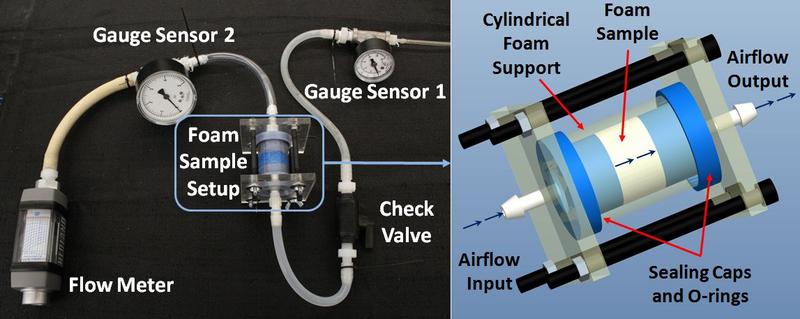
The flow rate measurements (in the pressures range of 0<∆P<100 kPa) demonstrate that ϕpore=0.7 foam has the highest flow rate, which we attribute to its higher porosity. The results show a nearly linear relationship between airflow rate and differential pressure. The sample-to-sample variability is likely due to the stochastic nature of the pore network and foam fabrication variables (salt crystal size, degree of foam stretching, and amount of air pumping to remove residual table salt). All porosities tested had a suitable flow rate for fluidic actuation, but foams with ϕpore=0.7 porosity seem to be the most suitable for soft machines because of their higher flow rate and greater ease of sculpting (due to their larger salt-to-elastomer ratio).
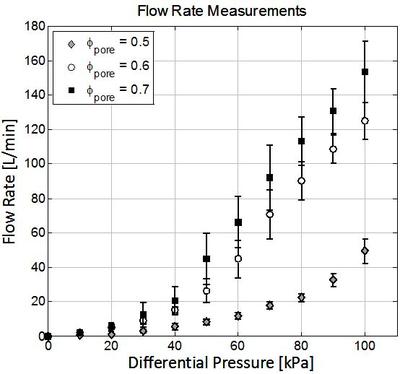
Table salt Soft Foam actuators tests: Blocked force measurement and Bending tests
Blocked force measurements to characterize the actuators' applied force as a function of inflation pressure have been performed, for casted and painted actuators both. We tested ϕ pore =0.7 foams with three sealing elastomers, (Mold Max 10, M4601, and OOMOO 30) each of which has a higher hardness than Ecoflex 00-10. We used an acrylic sample mount to constrain the bending actuator (30x105x8 mm size) to a constant curvature and a balance to record applied force. We increased inflation pressure from until the actuator failed (i.e., sealing rupture or bursting). The experimental setup and the results of these tests are reported in the figure below.
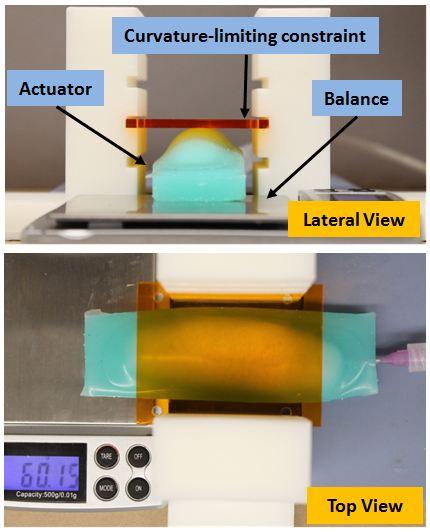
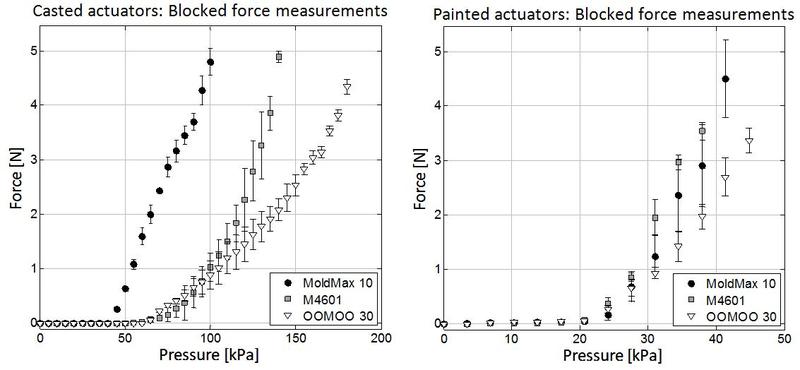
In addition, using Elastosil M4601 as sealant, we were able to lift different weights by inflating a similar actuator in accordance with the actuation force measurements for the selected elastomer, as shown in the Video "M4601 Actuator force".
Through the blocked force tests, we observed that actuation force is related to the mechanical properties of the sealing elastomer, as expected. Specifically, higher hardness seals required greater inflation pressures to initiate actuation and to attain a given endpoint force. We recorded actuation initiation pressures of 45 kPa, 55 kPa, and 65 kPa and maximum actuation forces of 4.79N, 4.88N, and 4.34N for Mold Max 10, M4601, and OOMOO 30, respectively.
Using the actuator sealed with Ecoflex 00-10, we measured the curvature as a function of the inflation pressure. By using a very soft foam and seal, we obtained high bending (curvature radius r = 25mm) with low pressures (27.5kPa), as reported in the figure.
